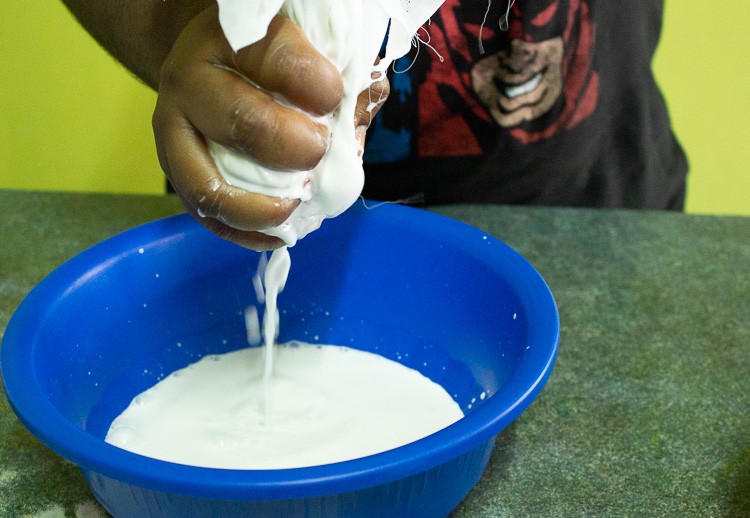Coconut milk is the essence of life in the Pacific Islands. It is used to make food, deserts and even coffees and skincare products. A brown coconut falling on a rooftop can be louder than the sound of a gunshot! Pacific Islanders and those that live in tropical regions of the world will relate to this frightening sound. It can happen at any time, middle of the day or middle of the night when the world is sleeping. People wake up in a fright and immediately ask, ‘what exploded?!’ In all seriousness though, falling coconuts can crack a person’s skull and cause severe injuries. So whenever you’re under a coconut tree, beware!
Coconuts are such an essential food source in many Pacific Islands, Asian countries and the Carribeans. The true flavour of coconut milk is only experienced when you grate and milk fresh brown coconuts. Brown coconuts fall off the coconut tree when they become old to make way for new growth (they are also seeds that develop into a new tree). These brown coconuts are not rancid but their skin will be brown, the husk dry, the flesh thick and the coconut water will taste different. You can consume a brown coconut raw, it is still quite delicious and nutritious.
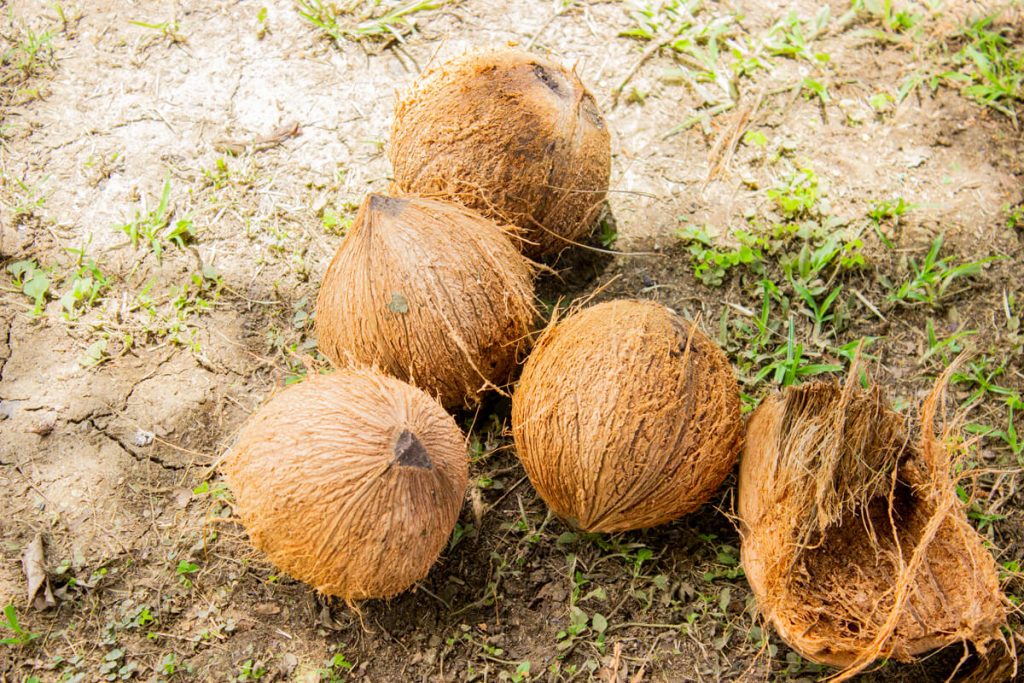
A brown coconut is used for many different purposes from food products (oil, milk) to skincare, lighting fires, kitchen utensils (bowls, ladles) and so much more. It is such a versatile crop that produces so many different types of products and is the heart and soul of the people from small islands that rely on coconuts for their livelihoods. Coconut milk has fast become an extremely popular import by western countries and this has helped many small economies to thrive. Locals are very dependent on coconut milk too, especially for cooking. Fiji’s food, for example, is sustained by coconut milk – from fresh Fijian seafood dishes and Indian curries to delicious desserts and snacks. While some people use canned coconut milk in their cooking nowadays, freshly grated and milked coconut is still preferred. It is more delicious and much cheaper to buy brown coconuts from a market vendor than to buy from a store. Some people also live near coconut trees and collect brown coconuts on a regular basis.
Steps to extracting coconut milk.
How to tell if a brown coconut hasn’t gone bad?
Although they can be stored for months at a time, sometimes brown coconuts begin to rot when they are unable to grow roots into the soil. It is difficult to tell if a coconut is bad just by looking at it. The most common and easiest way to know if the coconut has not gone off is to shake it. If you hear the sound of water inside the coconut, it is still good to go! In some cases, the coconuts can still turn out rotten even if the water within it is present. You can further test it by removing the husk and checking the eyes of the coconut. If it has sunken in then it has begun to rot. The only way to be 100% sure is ofcourse to crack it open. Sometimes you’ll get a beautiful surprise with a growth inside the coconut. Informally we call it the ‘flower’ of the coconut and it can be eaten – it has a beautiful taste. This flower is the result of it growing into a new coconut tree and definitely not a sign of decay. You can eat the flower and proceed to use the flesh of this coconut.
Husking the coconut
The removal of the tough, dry brown husk of the coconut can be quite a challenging and effortful task. Fijians use a spear-like metal to pierce and husk a coconut. Some experienced men and women can husk a coconut in less than a minute! A few very skilled people also husk the coconut with their teeth – they must have very strong jaws! Most people on the other hand, are able to husk a coconut with a machete. Watch this video for a full demonstration.
Cracking a coconut
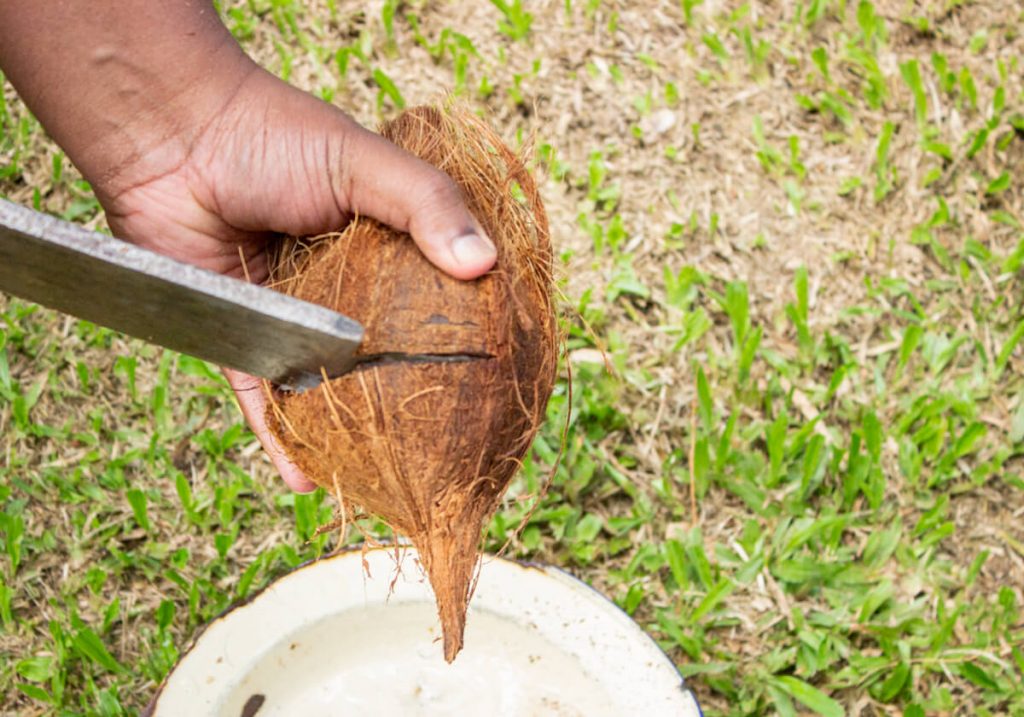
Once husked, the coconut is cracked into two – make sure to knock the shell with the back of the machete horizontally. Keep going right around the coconut till you see a visible crack. Then squeeze the tip of the machete into the crack and pry it open. Remember to keep a bowl handy to collect all the coconut water. You can either drink this water, use it for cooking or even give to your dog – they love fresh coconuts! Fijian dogs love it, but a western dog may not – check with your vet.
Grating coconuts for coconut milk
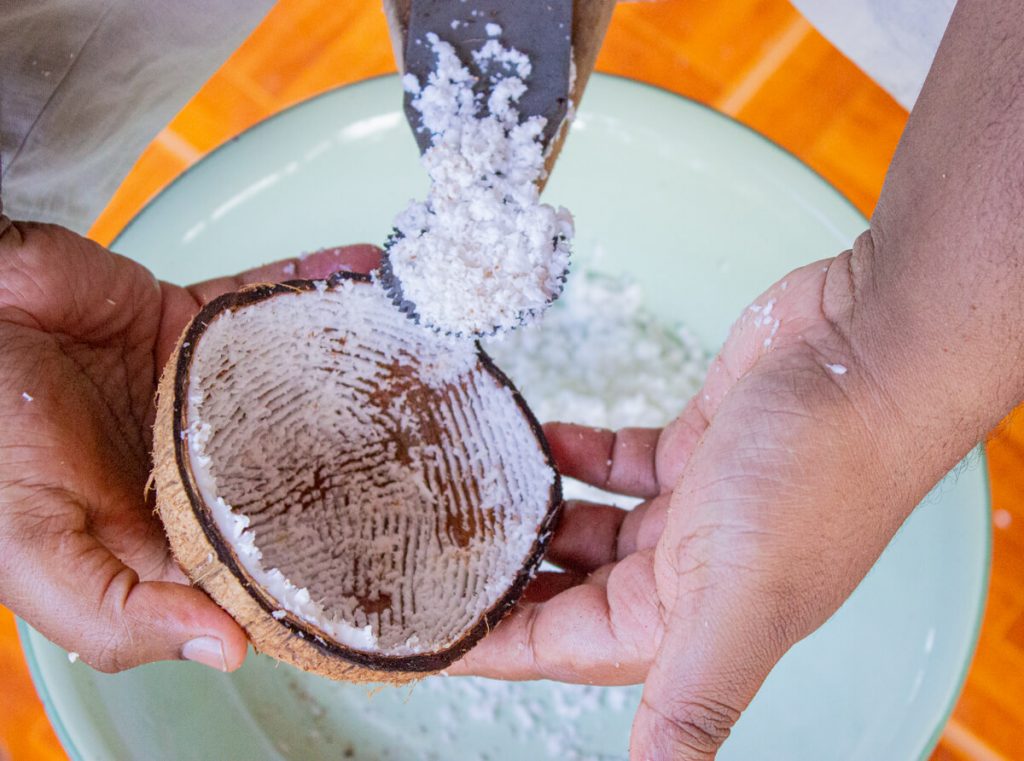
Using a coconut scraper, grate the flesh into thin, wiry strips. There are manual and mechanical coconut scrapers that you can use but using a normal food grater may not work well. You can alternatively cut the hard coconut flesh and pop them into a food processor. This will work just as well, maybe better for milking.
Milking the coconut
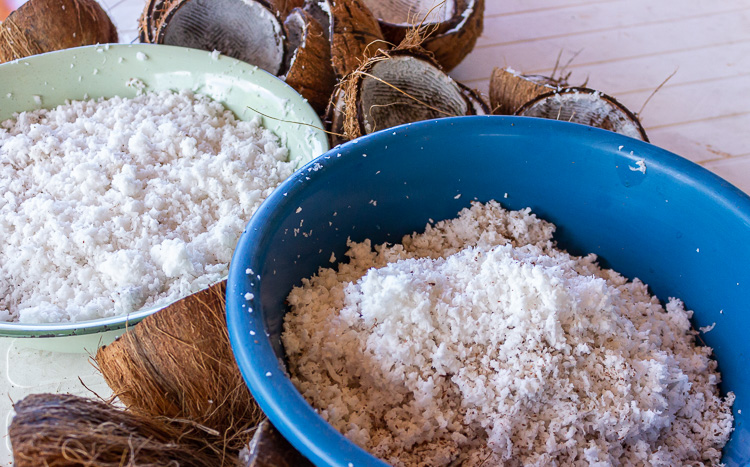
Once you have your grated coconut, grab a muslin or cheesecloth or any soft material and squeeze out all the milk from the coconut. Repeat this step once again by adding a little bit of water to extract all the milk from the grated coconuts. Then strain all the milk using a tea strainer and your milk is ready to use!
You can use this coconut milk to make coffees, curries such as this Fiji-Indian crab curry, Fijian traditional food, desserts and so much more.

